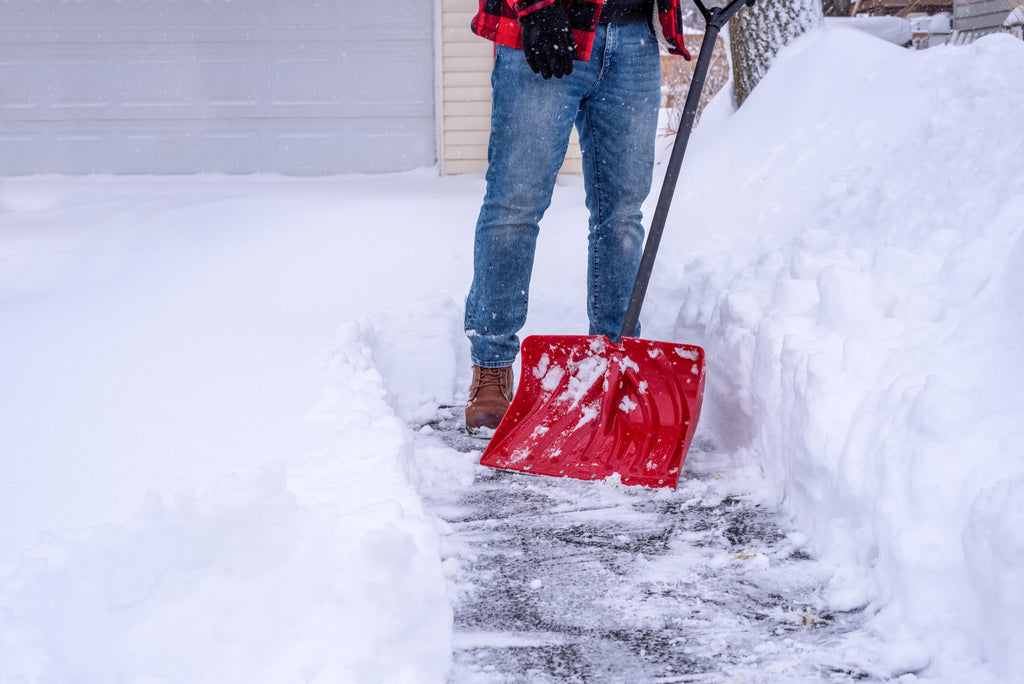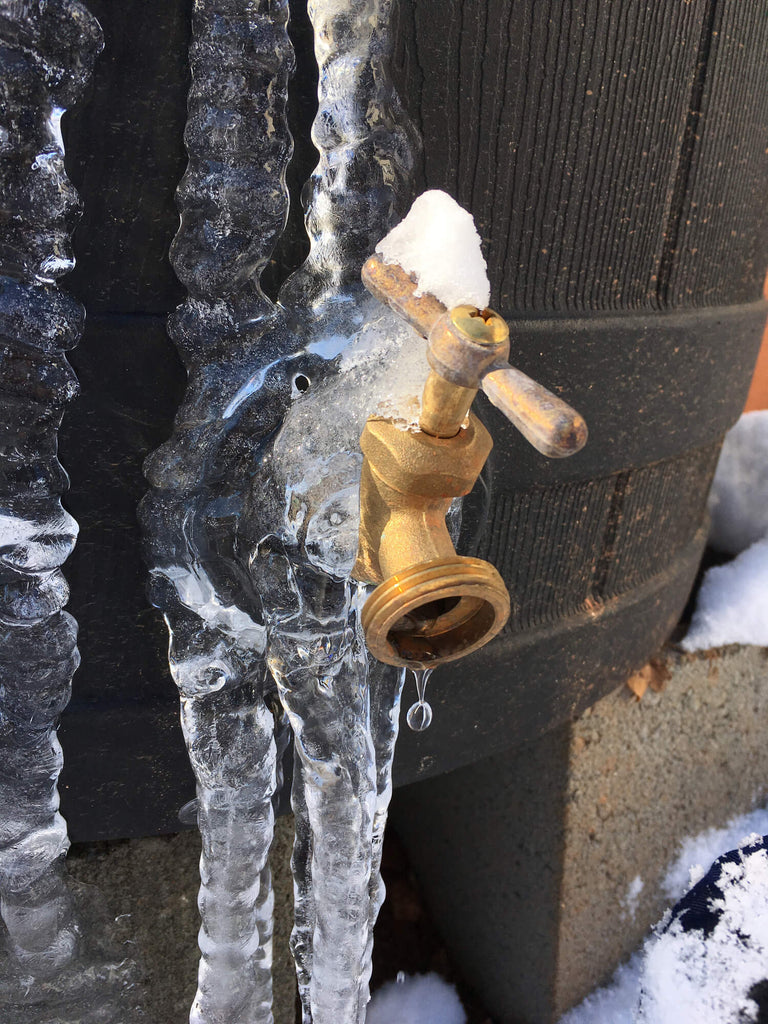
Rainwater harvesting is a great way to save water for outdoor use during the spring and summer, but it can be useful during the autumn and winter months as well. In most states, freezing weather poses a threat to above-ground rainwater storage tanks at some point during the winter. For homeowners that want to save water during this time of year, there are methods to keep rain barrels safe. Below you can find information on applications for winter rainwater harvesting, how to winterize a rain barrel in your climate, and things to avoid when winterproofing your system.
Why harvest rainwater and snow during the winter?Rainwater harvesting, the collection of rainwater that flows from your rooftop to your gutters, is common during the spring and summer because of the abundant outdoor uses for the collected water. When the weather turns cold, many of these uses no longer apply, but that does not mean that a rain barrel is useless during these months. Depending on the climate, both rainwater and snow can be used for outdoor and indoor applications in the winter. There are also methods to ensure that your water storage tank stays safe and operational during cold weather.
Winter applications for rainwater
While rainwater harvesting may seem odd during the winter, there are many reasons to do so during these months. Storing rainwater during the winter can help:
- Prevent runoff. If water pools under your gutters or downspouts constantly, then storing rainwater is essential during the winter.
- Water indoor plants. Rainwater is ideal for watering plants because it does not contain the chlorine and chloramines that tap water does. Christmas trees are excellent uses of rainwater during the winter.
- Wash cars. In climates that have warm afternoons during the summer, rainwater can provide water for washing your car. Not only does this save water, but it is also beneficial to your car’s paint compared to tap water.
- Provide drinking water. With appropriate filtration systems in place, rainwater can provide drinking water for your home. Rainwater collects contaminants on your rooftop, in your gutters, and along your downspout, so do not drink it without filtering it first.
Learn more: How to Collect Rainwater for Drinking
Can I use a rain barrel year-round?In many climates, harvesting rainwater is feasible year-round, but other regions are hard on the components of an above-ground rainwater harvesting system during the winter. If you live in a warm climate that rarely dips below freezing, you may not need to winterize your rain barrel at all. If the periods of freezing are short enough that water will not freeze, your rain barrel should remain safe. You can leave the spigot slowly dripping on nights when freezing weather is imminent. This slightly agitates the water inside the tank, dropping the temperature at which the water will freeze.
In cool climates that frequently dip below freezing during the winter months, you will need to either store your rain barrel somewhere safe, insulate it, or introduce a pump to the system.
In cold climates where the temperature can remain freezing for days at a time, you will likely need to store your rain barrel during the coldest months of the year. Constant freezing temperatures not only wreak havoc on your rain barrel, but they also threaten other components, such as the spigot, tubing, hose, and other attachments, of the tank as well. In this type of climate, you likely do not have a use for stored rainwater in outdoor applications, so storing your barrel during these months is the best option.
How to harvest snow with a rain barrelSnowfall can be harvested in a rain barrel in two ways: by melted snow flowing through your gutters and by manual collection. When snow melts on your rooftop, it will collect in your rain barrel just like rainwater. However, if the temperature does not rise above freezing for long enough to melt rooftop snow, you can manually add snow to your rain barrel. Using shoveled snow from your driveway is a practical application for manually harvesting snowfall. If your rain barrel is properly insulated, the snow will eventually melt, and you will have useable water for watering your indoor plants.

If you would like to harvest rainwater during the winter or simply do not have a suitable storage location for your rain barrel, there are a few options that can prevent your storage tank from freezing. You should only use a rain barrel during the winter in areas where freezing temperatures are rare and almost exclusively occur during nighttime. In very cold climates, such as Wisconsin or Minnesota, even moving water can freeze, so the risk of using a rain barrel during the winter outweighs the benefits.
To prevent water from freezing in your rain barrel, you can:
- Let the water drip overnight. If you know the temperature will dip below freezing during the nighttime, allow your water to slowly drip into a bucket or some other collection container. This applies motion to the stored water, lowering the temperature at which it will freeze.
- Wrap your tank in insulation. This will protect the tank all day long from freezing temperatures and sunlight. However, it will also likely cause the tank to lose its aesthetic appeal. If your home is subjected to an HOA, this solution will likely not work for you.
- Add a fountain pump to your tank. If temperatures drop low enough that slow dripping does not prevent freezing, a simple fountain pump may be suitable for your barrel. This is a more expensive option than the previous two, but it does not affect the aesthetic of your barrel and is more effective than a slow drip.
- Use a space heater. A space heater can provide warmth to an outdoor rain barrel, but caution should be exercised when using one. The heater should be kept on a flat surface away from any combustible materials. Additionally, space heaters should only be used sparingly, not around the clock.
- Use an underground rainwater storage tank. In very cold climates, underground rainwater tanks are the only reliable method to prevent freezing. They maintain consistent temperatures during all four seasons and save space in your yard.
Learn more: Above Ground vs Underground Water Storage Tanks | Advantages and Disadvantages of Rainwater Harvesting
What not to do with your rain barrel during the winter
Some methods of winter-proofing a rain barrel cause more harm than good. If you want to harvest rainwater during the winter, do not:
- Expose your tank to direct sunlight. This makes the barrel more prone to algae growth, even in cold weather.
- Wrap your tank in insulation if you are part of an HOA. Whether you use real insulation or other insulating materials, covering your rain barrel is likely to make it an eyesore that an HOA will not approve of.
Leave a heater running constantly. Space heaters are a fire hazard when operated under the wrong conditions, particularly outdoors. Heaters should only be run when they can be monitored and when necessary.

If you do not wish to harvest rainwater or snow during the winter, you have the option to store your rain barrel in a safe location. An indoor space is ideal for storing your rain barrel, but an outdoor location can be acceptable if the tank is kept out of sunlight and stored upside down. To properly store your rain barrel for the winter, follow these steps:
1. Drain the rain barrel.
Draining your rain barrel is essential before the first freeze of the year. When water freezes, it expands and will crack the structure of the storage tank. At this stage, you may want to clean the inside of your rain barrel, particularly if you are storing it indoors over the winter. If your storage tank does not have algae or bacterial buildup, a simple rinse will suffice. Ensure that you leave the spigot open once this step is completed.
Learn more: How to clean a rain barrel
2. Detach the rain barrel from the downspout.
To detach your rain barrel from the downspout, you may need pliers or a screwdriver. Removing the barrel should not require excessive force, so ensure that the barrel attachment is not latched onto the downspout before removing it. If you need to reattach the length of the downspout after removing the rain barrel, you can add it immediately after removing the tank attachment.
3. Remove all attachments from the rain barrel.
Before you store your rain barrel, remove all of the tank’s accessories. If water freezes to the lid, spigot, tubing, or other attachments, it can damage the ridges on the tank or the barrel itself. These components should be stored separately from the storage tank.
4. Store the rain barrel in a safe location.
After your barrel is free from attachments, you can store it in a safe location. Storing your tank indoors will elongate its lifespan, but you can store it outdoors if you do not have sufficient indoor space. Garages, sheds, and basements are all excellent places to store your barrel during the winter. If the barrel must be stored outside, ensure it is not exposed to direct sunlight. A rain barrel cover provides sufficient protection from sunlight, wind, rain, and snow. Tanks stored outdoors should also be kept upside down to ensure that rain or snowfall does not get inside. Should liquid get inside the tank, it can freeze and crack the shell of the barrel, causing the problem that storing your tank is supposed to prevent.
If you have any additional questions, please do not hesitate to contact us.




